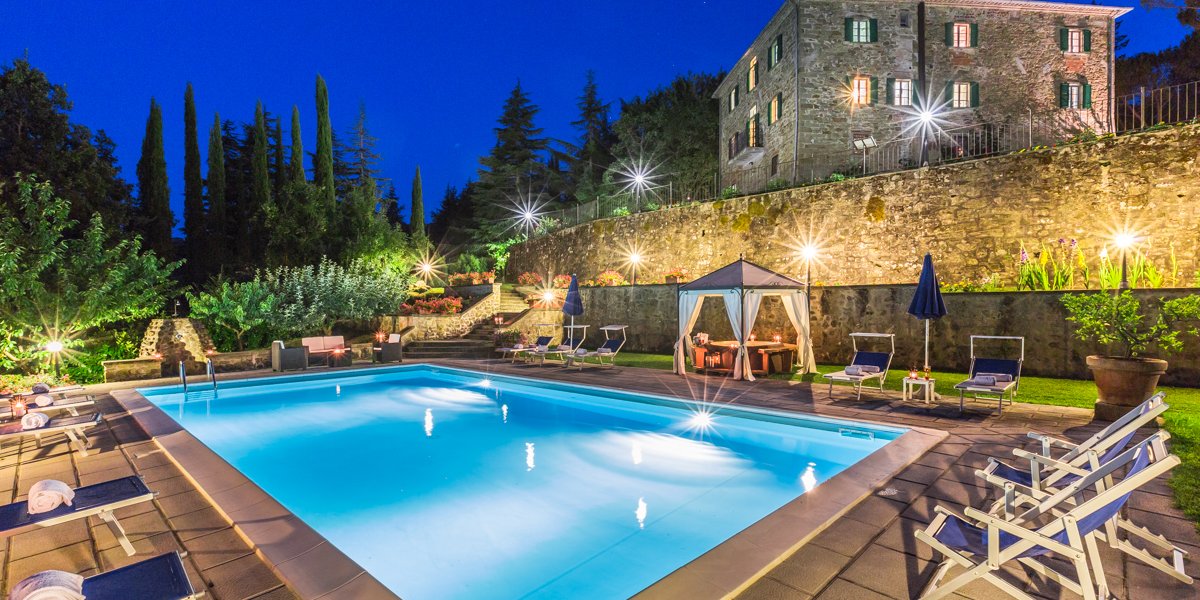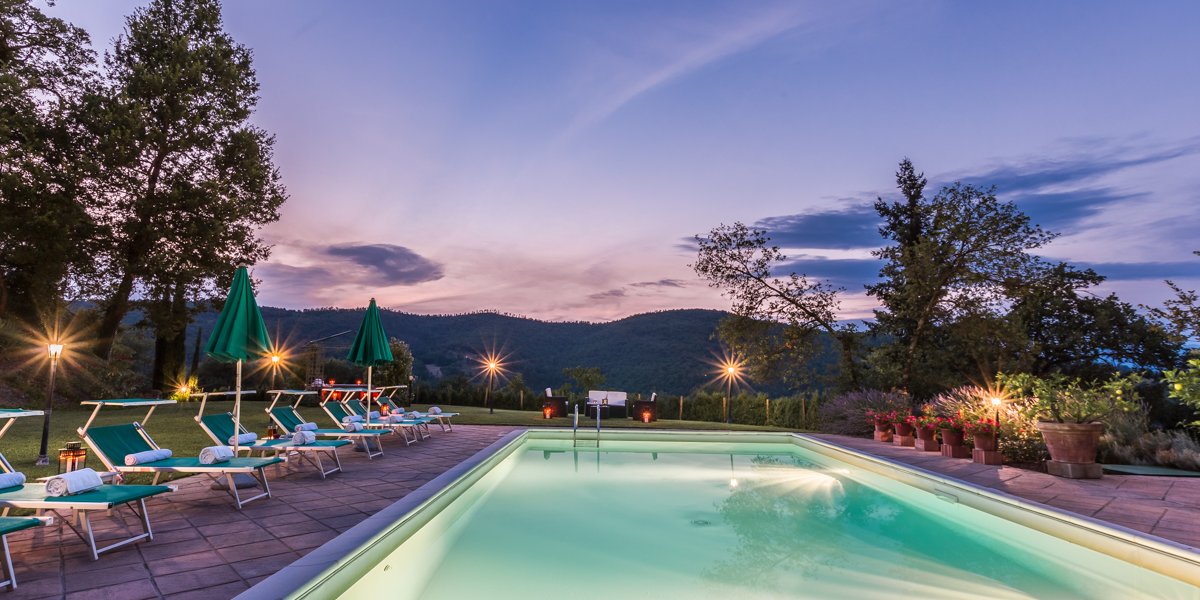Surroundings
Valtiberina Tuscany
The part of the Valtiberina (Tiber Valley) found in Tuscany consists of the portion of land between the regions of Romagna, Umbria and Marche.If you are planning to travel in Tuscany, Villas Palazzo Rosadi and Torre del Cielo give you the opportunity to visit the most important cities of art like Anghiari, Sansepolcro, Caprese Michelangelo, Citerna, Città di Castello, Gubbio, Arezzo and Perugia. A holiday in the Villas Palazzo Rosadi and Torre del Cielo is perfect for relaxation and enjoying the wonderful landscape of the Tuscan countryside and offers guests the opportunity to visit cities rich in art and culture.
Vacanza in Valtiberina Toscana
The Valtiberina is a valley which offers numerous holiday opportunities, be it for nature and ambience, or the artisan traditions, history, and the culture of its inhabitants. The historic-cultural importance that the Valtiberina has had over the centuries (see the presence of famous birth places eg, Michaelangelo and Piero della Francesca), and the local traditions of culture and hand made products, have made this area one of the most capable areas to satisfy all tourists to Tuscany (excursions, wine and food, environmental, cultural, religious and educational).
Anghiari
The town of Anghiari is antique and medieval, with irregular little roads, steep steps, churches and little squares with artisan shops, restoration and antique workshops.
The view overlooks the Tiber Valley, with its castles, towers and churches, testimony to its past Francescan spirituality.
Culturally Anghiari has much to offer, with the Museums of Palazzo Taglieschi and Palazzo Marzocco. In the first are a collection of paintings, sculptures and local tools; among the most important works are the Nativity by Andrea Della Robbia and the statue of the virgin by Jacopo della Quercia.
In the museum of Palazzo Marzocco you can find the history of the famous battle of Anghiari, illustrated by paintings.
There is also the museum of the Misericordia, which documents the history of the brotherhood of Anghiari whose origin dates back to around 1300, and which continues to be present in the area although it disappeared and reappeared over time.
The town of Anghiari hosts lively cultural activity with shows, exhibitions, displays, local celebrations, from local folklore to theatrical events to traditional cuisine.
Sansepolcro
Sansepolcro is located in the east part of the Tiber Valley near the border with Umbria. Due to its position between the Alps of the Moon and the Massa Trebaria, between the Umbrian hills and the Alps of Catenaia, it is the perfect starting point for every type of excursion. Sansepolcro seems to be a medieval town, built within four walls, but very lively and modern.
The medieval town is famous because it’s the birth place of Piero della Francesca (1415-1492), whose work (the "Madonna della Misericordia" and the "Resurrezione") are on display in the Museo Civico. Other museums in Sansepolcro are the Aboca museum, the Spazio del Merletto and the Bernardini-Fatti della Vetrata Antica, where you can see a large representation on glass of the Last Supper and other antique glass work made by artisans and artists of the Tiber Valley.
Among the more interesting buildings are the Cathedral of S.Giovanni Evangelista and the Churches of S.Maria delle Grazie, S.Maria dei Servi, S.Lorenzo (inside you can see the Deposizione by Rosso Fiorentino), S.Rocco, S.Agostino and the monastery of San Francesco in Montecasale. There are many local events in Sansepolcro like the title="Balestrieri Sansepolcro - Palio della Balestra Sansepolcro Tuscany">Palio della Balestra (second Sunday of September), with archery competitions, costume parades and flag bearers.
Events in Sansepolcro
> Palio della Balestra and exhibition of flag wavers
Sansepolcro, Palio della Balestra Since 1951 on the second Sunday of September in Sansepolcro the evocative Piazza Torre di Berta with its Renaissance palaces, holds the historical competition of the Palio della Balestra (a crossbow tournament) during wich the crossbow-men of Sansepolcro challenge those from Gubbio.
The tournament is preceded and followed by corteges in which medieval costumes are worn, inspired by the paintings of Piero della Francesca.
After the crossbow blessing, the crossbow-men of both towns come into the square after the flag-waving demonstrations and the rolls of drums.
The crossbow-men, wearing Renaissance costumes, take turns in shooting and the silence is broken only from the shot of the bolt in the cornel. In the square there is a revival of old tournaments.
The Palio shows the beauty of Sansepolcro simply because offers to visitors charming views together with ladies and knights, religious silence before every shot, concentration, colours and art…these are all the elements of this manifestation wich is the peak of "Settembre Biturgense", a calendar of cultural, culinary events and historical manifestations worthwhile consulting for a visit of Sansepolcro.
In this beautiful background, on the evening before the Palio della Balestra, the traditional performance of the Giochi di Bandiera(Flag-waving show) takes place. Flag-wavers show several aspects of the flag waving art by following the historical traditions. The show consists of several individual performances (up to three flags) and in pairs, the whole demonstration accompanied by the roll of dreams.
Caprese Michelangelo
Caprese Michelangelo is the birth town of Michelangelo Buonarroti, from which the little town takes its name. It is located on a very high position, dominating the surrounding area. The area around the small town (1700 population) consists of exceptional chestnut groves, which were awarded the "Marrone di Caprese Michaelangelo" denomination of origin protected.
In the Casa del Podestà, where Michaelangelo Buonarroti was born, you can find the Museum of Michelangelo, with reproductions of the main masterpieces of the artist as well as work of his contemporaries.
Events in Tuscany
> "Il Mercatale"
Toscana, Il Mercatale
"Mercatale" is a local typical products market. It is a regular meeting with our tradition excellences directly from the producer to the consumer. You can find seasoned products, traceability of production process and transparent prices.
Producers promote suitable initiatives in order to inform consumers and assure for a monthly edition of this market:![]() particular care for the preparation of their own stall for increasing the value of products and informing the consumer
particular care for the preparation of their own stall for increasing the value of products and informing the consumer![]() observance of regulations in force about preparation, transportation and sale of products
observance of regulations in force about preparation, transportation and sale of products![]() clear and exhibited prices
clear and exhibited prices![]() a presentation of their own activity with documents about the farm and the products’ features
a presentation of their own activity with documents about the farm and the products’ features![]() labels of product understanding
labels of product understanding
Cultural activities and meeting activities with consumers and visitors, such as:![]() Guided tastings
Guided tastings![]() Presentation of productions
Presentation of productions![]() Exhibition of local material culture
Exhibition of local material culture![]() Presentation of quality restaurants
Presentation of quality restaurants![]() Animation
Animation
"Mercatale" takes place:
In Arezzo on the first Saturday of every month
In Montevarchi on the second Saturday of the month
In Sansepolcro on the third Saturday of the month
In Bibbiena on the fourth Saturday of the month
In Castiglion Fiorentino on the fourth Sunday of the month
Events in Arezzo
> Antiques Fair
Arezzo, Fiera Antiquaria Every first Saturday and Sunday of month antique dealers, collectors, craftsmen, lively stores and stalls with objects of every type invade the streets, lanes and squares of the medieval town of Arezzo in more than 10000 square metres of surface.
The antiques fair gathers about 500 exhibitors coming from all Italy. To visit this fair could surely be a great chance to discover the story and the artistic treasures of one of the most beautiful town of Tuscany.
The exhibitors offer with their objects a survey of cultural traditions and local customs, a point of reference for many collectors.
Exhibitors of furniture, prints and valuable antiques overflow the town without a logical order but let the visitors to discover the most secluded corners of the town and the most refined and particular objects.
We recommend to all our clients to dedicate one day at least to the visit of the town of Arezzo and this fanciful fair.
Contact us for a special accommodation offer on the occasion of this particular event.
> Giostra del Saracino (Saracino Joust)
Giostra del Saracino is an historical recalling which takes place in Arezzo every year on the second-last Saturday of June ( St. Donato Tournement, patron of the town) and (September Tournement). The four quarters in which the town is divided take part to this challenge: Porta Crucifera (also known as Colcitrone), Porta del Foro (also known as San Lorentino), Porta Sant’Andrea and Porta Santo Spirito (known as Quarter of Colombina).
The joust of chivalry takes place in the beautiful setting of Piazza Grande. It open with the entry in the square of the historic cortege with the ancient town gonfalons under the Grand Master order. Salient moments are the entry of the most important authorities of the joust, the exhibition of flag-wavers, the entry of jousters at a gallop, the competing knights of clan (who represent the old nobility of Arezzo), the herald’s reading of the Disfida of Buratto and finally the crossbow-men greeting.
The competition consists of riding full gallop, lance in rest, towards the so called Saracino, such as an armour-plated automaton who represents an armed Saracen. The jousters are usually eight and they take turns in competing with courage and ability on a dirt track in Piazza Grande. Winner of the competition is the couple of jousters who gets the top score by hitting the Saracen’s shield. The prize is a gold lance.
At the end of the joust, shots are fired in honour of the winning quarter. The tournament rules are contained in a technical regulation and date back to the chapters of Buratto Jouster of 1677. The battle result between the Christian knights and the "faithless man" is uncertain till the end owing to unexpected turns of events (such as disqualification of a jouster or doubling of score).





